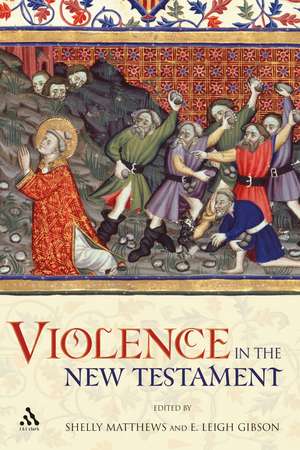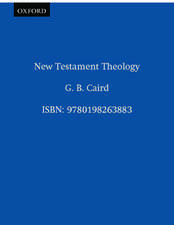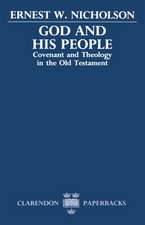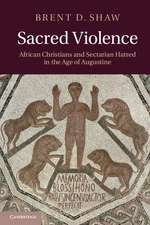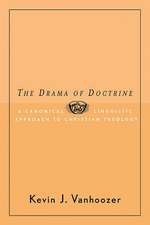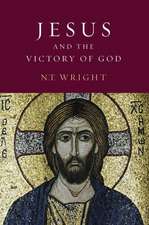Violence in the New Testament
Editat de Shelly Matthews, E. Leigh Gibsonen Limba Engleză Paperback – 30 apr 2005
Preț: 177.32 lei
Preț vechi: 231.70 lei
-23% Nou
33.93€ • 35.23$ • 28.30£
Carte tipărită la comandă
Livrare economică 24 martie-07 aprilie
Specificații
ISBN-10: 0567025004
Pagini: 168
Dimensiuni: 154 x 231 x 10 mm
Greutate: 0.27 kg
Ediția:New.
Editura: Bloomsbury Publishing
Colecția T&T Clark
Locul publicării:New York, United States
Cuprins
List of Contributors and Topics: 1. Richard A. Horsley (University of Massachusetts, Boston), "Imperial Violence and the Historical Jesus" 2. John G. Gager (Princeton University), "Violence and Paul" 3. Melanie Johnson DeBaufre (Luther College), "Violence and the Q Community" 4. Warren Carter (Saint Paul School of Theology), "Representing Violence and Matthew's Gospel: Violent Jews? Non-Violent Christians?" 5. Adele Reinhartz (Wilfrid Laurier University), "The Rhetoric of Violence in the Gospel of John" 6. John W. Marshall (University of Toronto), "Collateral Damage: Insider Violence in John's Apocalypse" 7.Shelly Matthews (Furman University), "The Need for the Stoning of Stephen" 8.David Frankfurter (University of New Hampshire), "Afterward"
Recenzii
-Mention. Theology Digest/ Vol. 52 No. 3/ Fall 2005
"[T]his collection of essays in an invaluable addition to New Testament studies that should stimulate much discussion. It raises key issues relating to the violent language of the new Testament and, one hopes, will fuel much research in this vital area and facilitate a mutual consideration of the New Testament from the perspectives of Jewish and Christian scholars alike."- Mark Bredin, The Society of Biblical Literature, January 2006
"At a time of growing concerns about religion and violence many Christians have exempted their tradition from much-needed scrutiny. The distinguished contributors to Violence in the New Testament remind us that violent themes and expectations lie at the heart of the New Testament and need to be understood and challenged." -Jack Nelson-Pallmeyer
"Violence in the New Testament addresses a topic of enormous importance--far too often ignored -- in New Testament studies." -Elaine Pagels, Princeton University
"Derived from lectures given to the Society for Biblical Literature, these essays delve into violent language and depictions of violence among Jews in the New Testament. Contributors challenge the basic assumption that the New Testament is solely a work of love, mercy, and peace. Content is analytical and theoretical, with endnotes for further detailed research. The scholarly style, a very usable index, and references make this collection of essays helpful to those seeking new perspectives about the causes and motivations for the violence that appears in the New Testament." - Church and Synagogue Library Assocation, Nov/Dec 2005
"The collection includes a splendid essay by Richard Horsley. "By the finger of God: Jesus and Imperial Violence" offers an excellent overview of his innovative research, sustained by suggestive exegesis, which locates Jesus's message as a challenge to a world shaped and scarred by imperial violence, where terror is an instrument of policy." Church Times, March 2006
'Collectively...the essays function powerfully to call into question the notion of Jewish violence directed against the early Jewish followers and, as such, this collection is to be commended.' ~ Lloyd K. Pietersen, Vol 28.5, 2006
"...a rigorous reassessment of how best to interpret the use of violence in these texts.... The goal is to help modern-day believers correctly understand the mention of violence in the New Testament as not supporting the 'Jew as violator' vs. 'Christian as violated' theological dichotomy that may have given rise historically to much anti-Semitism." -Library Journal, 5/1/05
Descriere
While much work has been done on the role of Jews in the crucifixion of Jesus in post-Holocaust biblical scholarship, the question of violence in subsequent community formation remains largely unexamined. New Testament passages suggesting that early Christ-believers were violently persecuted--the "stone throwing" passages from John, the "persecuted from town to town" passages in Matthew, the stoning of Stephen in Acts, Paul's hardship catalogue in II Corinthians, etc.-- are frequently read positivistically as windows onto first century persecution; at the other extreme, they are sometimes dismissed as completely a-historical. In either case, scholars up until now have provided little in the way of methodological reflection on how they have reached such conclusions. A further problematic issue in previous readings of passages suggesting such violence is that the perpetrators of violence are frequently cast as "Jews" while the violated are cast as "Christians," in spite of the growing consensus that it is impossible to tease out these two distinct and separate religious identities, Jew and Christian, from first century texts.This volume takes up crucial methodological questions about how to read passages suggesting violence among Jews in texts that eventually became part of the New Testament canon. It situates this intra-religious violence within the violence of the Roman Imperial order. It provides new readings of these texts that move beyond the "Jew as violator"/"Christian as violated" binary.
